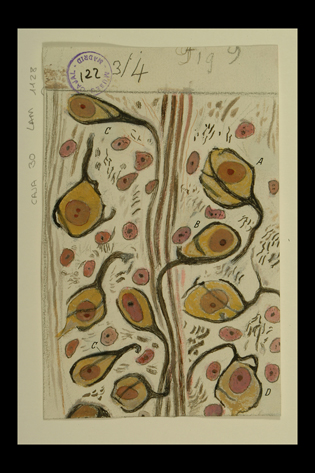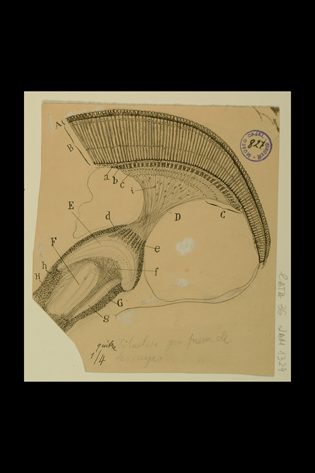New Partnership with Spanish Neuroscientists
Second Set of Cajal Drawings on Loan from Spain

COURTESY OF CSIC INSTITUTO CAJAL, MADRID, SPAIN
A Ramón y Cajal original: A drawing of Calyx of Held synapses, which are unique neuron communication points used in hearing. It’s one of seven original Ramón y Cajal’s drawings on display in the Porter Neuroscience Research Center.
On October 28, 2015, neuroscientists from Spain and the NIH gathered in the Porter Neuroscience Research Center (PNRC) for a daylong symposium that honored Santiago Ramón y Cajal, the Spanish scientist who in 1906 shared the Nobel Prize in Physiology or Medicine in recognition of his work on the structure of the nervous system. Cajal, known as the father of modern neuroscience, was a prolific medical artist and produced hundreds of drawings depicting the organization of nerve cells in the brain. Seven of those original drawings had been displayed at the PNRC since 2014. The symposium marked the installation of seven new drawings to replace the first set and the beginning of a new scientific partnership between NIH and Spanish neuroscientists.
“Ramón y Cajal showed how the nervous system is connected,” said Jeffrey Diamond, symposium organizer and a senior investigator in the National Institute of Neurological Disorders and Stroke (NINDS). “We hope to strengthen our connections with neuroscientists in Spain.”
In 2013, Diamond visited the Cajal Institute in Madrid to study Ramón y Cajal’s drawings. While he was there, he proposed that NIH borrow some of them to be exhibited in the newly finished PNRC. The Cajal Institute directors agreed, and the first set of drawings was unveiled at NIH on November 6, 2014, in an exhibit created by Hank Grasso of the Office of NIH History and Museum. They included drawings of neuronal circuits in the retina, spinal cord, and cerebellum.
The experience was so successful that the Cajal Institute agreed to loan a second set of drawings, which were put on display in conjunction with the symposium. In addition, the event marked the beginning of a scientific partnership that features joint talks given by NIH and Cajal Institute scientists.
“We want neuroscientists here and in Spain to share their ideas [that] are ultimately rooted in the drawings of Santiago Ramón y Cajal,” said Diamond.
The first set of drawings was returned to Spain in September 2015. The current set arrived on October 26 and was installed at the PNRC on October 27. They include drawings of brain cells called astrocytes, drawings of growing neurons, and a circuit diagram of the olfactory bulb, the part of the brain that detects odors.

COURTESY OF CSIC INSTITUTO CAJAL, MADRID, SPAIN
Cajal’s drawing above details the many ommatidia (small unit eyes) present in a single fly eye, as well as the neural circuitry relaying visual signals toward the brain. The insect and vertebrate visual systems are similar in that they have intermediary neurons that receive information from photoreceptor cells and direct it towards the neuropil or “neural switchboard.”
During the symposium, pairs of NIH and Spanish neuroscientists who had similar research interests gave talks matched to the drawings. NINDS senior investigator Leonardo Belluscio and Spanish neuroscientist Laura Lopez-Mascaraque described the development of the olfactory bulb. Heather Cameron (National Institute of Mental Health) was paired with Jose Luis Trejo to talk about their work on newborn neurons in the hippocampus, a part of the brain associated with learning and memory. NINDS investigator Bibi Bielekova and Fernando de Castro discussed their studies on multiple sclerosis, a disorder in which the myelin that insulates neurons is destroyed. Christopher McBain (National Institute of Child Health and Human Development) and Juan de Carlos described the development of circuits in the brain’s cortical regions.
In addition, two artists—Dawn Hunter from the University of South Carolina (Columbia, South Carolina) and former NINDS artist-in-residence Rebecca Kamen—spoke about how Santiago Ramón y Cajal inspired their work. Hunter’s drawings and Kamen’s sculptures are on display in the PNRC.
The final keynote lecture was given by neuroscientist Rafael Yuste, a professor at Columbia University (New York). Yuste was born and raised in Madrid and later moved to the United States to start his own laboratory.
“Santiago Ramón y Cajal is why I became a neuroscientist,” Yuste said. “After reading his book Advice for a Young Investigator, I started my career at Instituto Cajal. I’m proud to represent Spanish science in the [United States] and abroad.”
Yuste also discussed the importance of the Brain Research through Advancing Innovative Neurotechnologies (BRAIN) initiative, which was launched by President Barack Obama in April 2013. In 2011, Yuste was one of six authors of a white paper that became the foundation for the initiative.
“To fix neurological disorders, we need to understand the circuitry behind them,” said Yuste. “Just as Ramón y Cajal used new methods to resolve the neuron theory, we need to use and develop new technologies to take the next step towards understanding the brain.”
After the symposium, the speakers attended a reception at the residence of the Spanish ambassador.
“Today’s celebration was a truly unique moment for the NIH, Instituto Cajal, and the global neuroscience community,” said NINDS Director Walter Koroshetz.
The current installment of drawings will be on display on the first floor of the PNRC (Building 35) through early fall 2016. For more information, visit http://www.ninds.nih.gov/news_and_events/events/Cajal_Symposium_2015.htm.
This page was last updated on Wednesday, April 13, 2022
